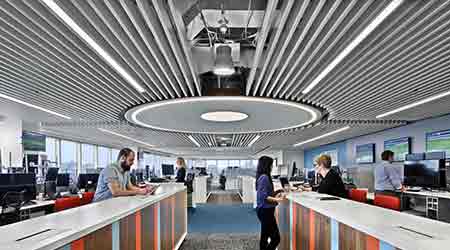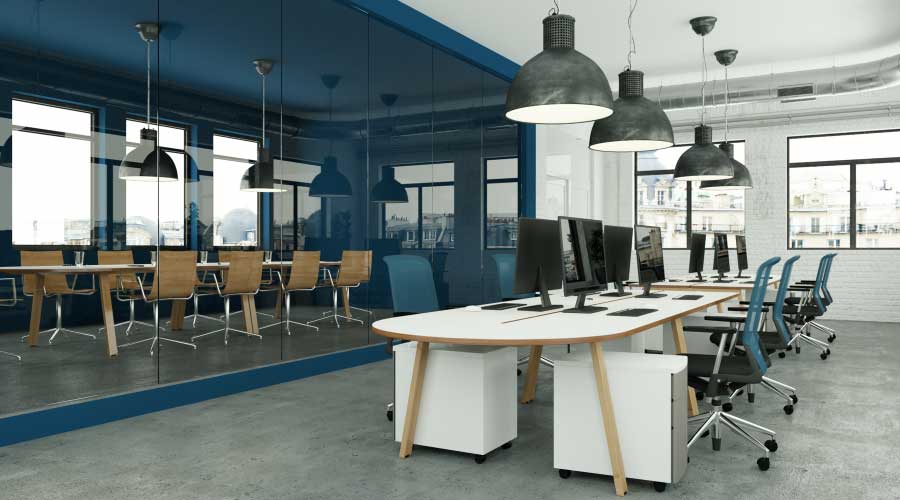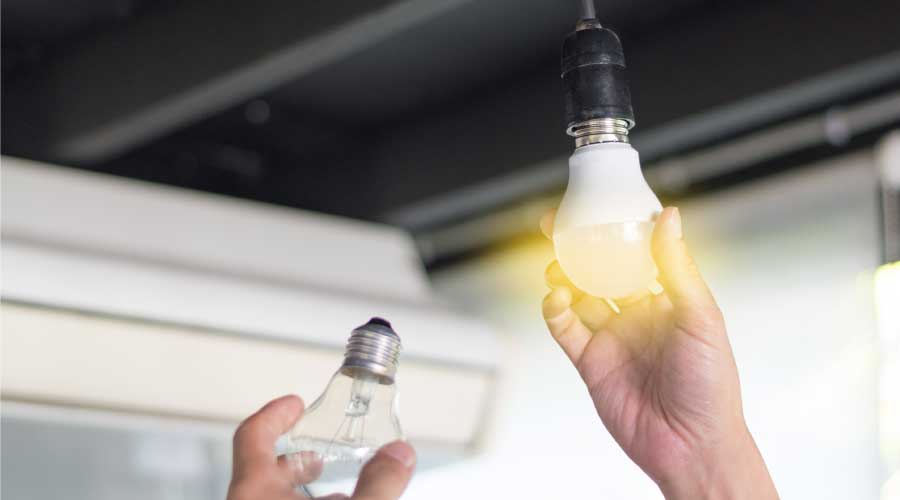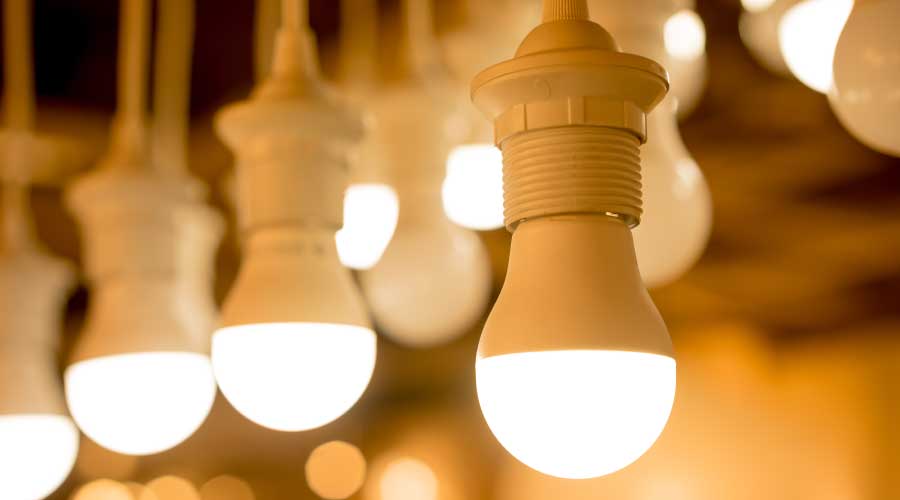 Nasdaq’s LEED Platinum Philadelphia office achieved a lighting power density 51 percent better than ASHRAE 90.1-2007. The space uses LEDs along with digitally addressable dimming controls, including daylight-responsive dimming controls in perimeter spaces. (Designer: HOK. Lighting design: The Lighting Practice.)©2017 Eric Laignel Photography
Nasdaq’s LEED Platinum Philadelphia office achieved a lighting power density 51 percent better than ASHRAE 90.1-2007. The space uses LEDs along with digitally addressable dimming controls, including daylight-responsive dimming controls in perimeter spaces. (Designer: HOK. Lighting design: The Lighting Practice.)©2017 Eric Laignel PhotographyLEDs and Other New Tech Complement Advanced Daylight Harvesting Systems
Lighting controls, networked systems, and wireless systems are all part of the new equation for ultra-efficient lighting.
Daylight harvesting is one component of very efficient lighting systems. A second element is LEDs. A good example is Nasdaq’s LEED Platinum Philadelphia office, which combines daylight-responsive dimming controls in all perimeter spaces with LEDs and digitally addressable dimming controls.
According to the Department of Energy (DOE), linear fluorescent lamps consume nearly 70 percent of all commercial lighting energy in the United States and account for 80 percent of commercial lamp inventory. A recent DOE study estimates that the U.S. General Services Administration could save roughly 30 percent of its lighting electricity consumption annually by replacing linear fluorescents with LED lamps. Under GSA’s Green Proving Ground Program, three federal test sites equipped with prismatic-lensed troffers confirmed significant LED energy savings — between 27 percent and 29 percent — when compared to baseline T8 fluorescent lamps.
“Because LEDs are inherently brighter, we could downsize from three lamps to two,” noted Brett Stubbs, building manager at Cabell Federal Building in Dallas, one of the three sites retrofitted. “We found this to be particularly effective in our perimeter zones.”
The Green Proving Ground study also noted wide variation in both the design and performance of LED retrofit options. The study observed that two linear LED products with similar illuminance ratings delivered different light outputs. Hasan recommends obtaining samples of new products to review their performance.
In addition, he recommends always providing access to lighting fixtures and power supplies to ensure a well-maintained system. “No matter what the rated life of an LED is, it is still an electrical component with the potential of failure,” Hasan explains.
“To ensure a maintainable system, we typically work with lighting manufacturers to ensure their products have easily replaceable components,” observes Hasan.
Even though prices have come down, initial costs for LED systems can still be more expensive that traditional fluorescent systems. Hasan points out that many energy suppliers offer rebates for installing or converting to LED products. Typically, these rebates require products certified by Energy Star or the Design Lights Consortium.
Controlling light
Today’s advanced lighting control systems rely on sophisticated programming to switch, dim, and brighten lights in response to occupancy and daylight, maximizing the efficiency of solid-state lamps. Advanced lighting control systems include networked lighting and connected lighting systems.
GSA’s Green Proving Ground program hired LBNL to evaluate plug-and-play LED fixtures with advanced lighting controls in the Ralph M. Metcalfe Federal Building in Chicago and the Peachtree Summit Federal Building in Atlanta. LBNL researchers found the fixtures maintained lighting quality, offered a simplified control system setup, and achieved lighting energy savings of 69 percent as compared to the GSA average and 75 percent compared to the national average.
The use of LED technology accounted for 41 percent of the savings on its own. Advanced lighting controls picked up the rest of the savings, reducing energy consumption by 28 percent compared to the GSA average and 34 percent compared to the national average. The LBNL study also found positive return on investment for both retrofits and new construction.
“The system was so easy to set up that it literally took us less than an hour to commission all 300 fixtures — and we didn’t need an engineer or program specialist to do it,” said Joshua N. Westhouse, building manager of the Chicago federal building.
Fixtures operate both independently and as a group. For example, all fixtures in a zone turn on to a minimum background level if any area within the zone is occupied. However, only the fixtures that sense occupancy brighten to full output.
Networked systems
“In the past, lighting control systems simply controlled the lights,” observes Steven Mesh, lighting designer and principal of Lighting Education & Design. “They are completely different now. They are networked lighting control systems using computers to talk to each other and to provide sources of input and output information like lighting loads.”
These networked control systems are starting to gain traction in the market. “Digital networked lighting control systems have become more common in larger facilities and allow a facility to monitor and manage their lighting system from a central point,” explains Hasan. “The facility would have the ability to more efficiently maintain the building lighting, and also shed load if needed.”
According to Mesh, the networked lighting control systems with the most functionality are generally proprietary and operate on their own networks. While many can interface with building management systems by talking BACnet, Mesh says interoperability generally reduces the networked lighting system’s functionality considerably. In Mesh’s experience that reduced functionality also reduces opportunities for energy saving. “Also, someone has to program in the information you want on your BMS,” Mesh points out.
Advanced control systems require careful planning. “One of the challenges with controls is that newer energy codes have more complex control requirements with redundant methods of turning the lighting on or off,” points out Hasan. “With more complex controls, it’s important to properly define how the system is supposed to operate by writing a sequence of operations into construction documents. Scheduling time for the design team to be part of the commissioning process also helps to ensure a system operates as expected.”
Wireless systems
Smart lighting controls can be wired or wireless, depending on the specific application. In existing construction, wireless generally is easier to install, but wired systems can offer more functionality.
A recent lighting retrofit at Pepperdine University’s Drescher campus used wireless controls to maximize energy efficiency. The control solution included wireless occupancy sensors, switches, and relay modules, as well as wireless wall switches. Costs were covered by utility incentives.
Mesh also points to a networked wireless lighting control system installed at a University of Santa Cruz laboratory building, which wanted to retain its T8 lighting but still make very deep cuts in lighting energy use.
“They wanted the fixtures to turn the lights way down in areas that were not occupied during the day,” explains Mesh. “But they didn’t want them to turn off because when the fixtures turned off the relays produced a clicking sound. That clicking sound could be startling to someone handling a potentially dangerous chemical in a beaker.”
Turning fluorescents on and off also cuts lamp life. By using a computerized system that was designed specifically for lighting control, these nuances could be accommodated by the manufacturer’s software.
A step beyond networked lighting controls are connected lighting systems, which are wired. Typically, connected lighting systems are Power over Ethernet (PoE) applications, where solid-state lighting uses a single Ethernet cable to provide low-voltage direct current power and to enable network communication.
PoE offers cost savings by transmitting power and communications over the same low-voltage cable, thereby freeing wireless bandwidth for other applications in the building. Several manufacturers now have PoE lighting systems.
“Connected lighting has huge potential to improve lighting quality, save energy, and provide new services,” says Michael Poplawski, a Pacific Northwest National Laboratory engineer managing DOE’s Commercial Lighting Test Bed. “But the convergence of LEDs and networking capabilities makes for a complex technology landscape. That’s where we can help.”
According to the Executive Summary of PNNL’s “PoE Lighting System Energy Reporting Study, Part 1,” connected lighting systems “that report their own energy consumption can deliver increased energy savings over conventional lighting solutions by facilitating data-driven energy management.”
Rita Tatum, a contributing editor for Building Operating Management, has more than 30 years of experience covering facility design and technology.
Email comments and questions to edward.sullivan@tradepress.com.
Related Topics:














